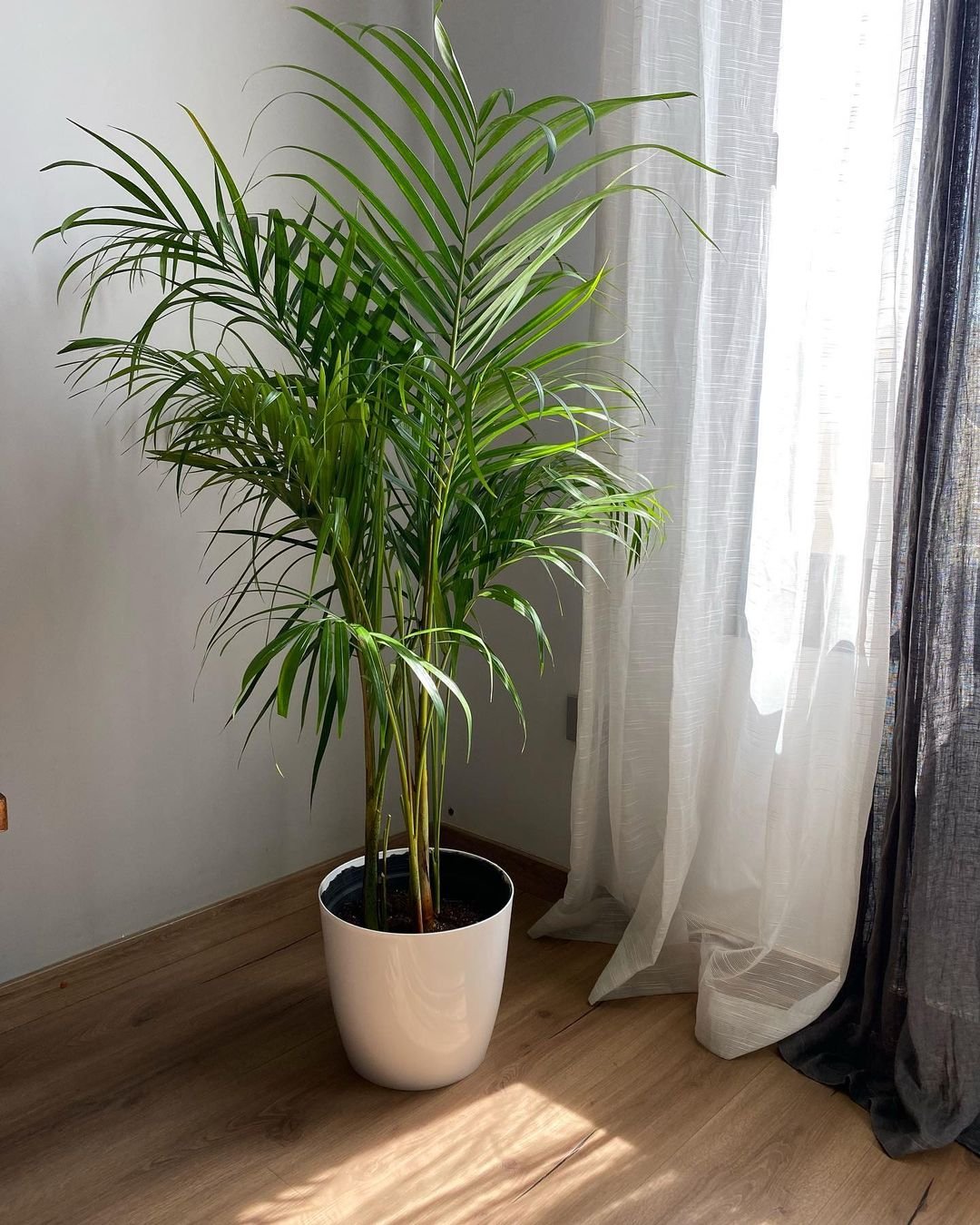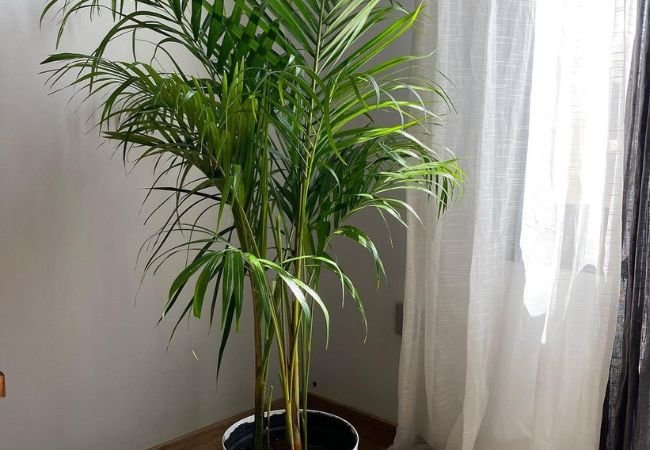Discover how to grow and care for the Areca plant with our complete guide. Learn essential tips on watering, lighting, soil, and more to keep your plant healthy and thriving.
The Areca plant, scientifically known as Dypsis lutescens or Butterfly Palm, is a popular indoor plant that brings a tropical flair to homes and offices. With its graceful, feathery fronds and relatively easy care requirements, it’s no wonder this plant has become a favorite among plant enthusiasts and beginners alike. In this comprehensive guide, we’ll explore everything you need to know about growing and caring for your Areca plant, ensuring it thrives for years to come.
Getting to Know Your Areca Plant

Here’s a short information chart about the Areca Plant:
| Name: | Areca Plant |
|---|---|
| Scientific Name: | Dypsis lutescens (formerly known as Chrysalidocarpus lutescens) |
| Common Names: | Areca Palm, Butterfly Palm, Yellow Palm |
| Description: | A tropical palm with feathery, arching fronds arising from a clustering, slender trunk. |
| Native To: | Madagascar |
| Light: | Bright, indirect light; can tolerate some direct sunlight |
| Water: | Keep soil consistently moist during growing season; reduce watering in winter |
| Humidity: | Prefers high humidity but adaptable |
| Temperature: | Thrives in average room temperatures; avoid drafts and cold extremes |
| Fertilizer: | Balanced liquid fertilizer monthly during growing season |
| Propagation: | Seeds, division of offshoots |
| Common Uses: | Popular indoor plant, office decoration, landscaping in tropical climates |
| Special Notes: | Non-toxic to pets; can be sensitive to overwatering and low humidity |
The Areca palm is native to Madagascar and naturally grows in tropical and subtropical regions. In its natural habitat, it can reach impressive heights of up to 30 feet! However, when grown indoors, it typically stays more manageable, usually reaching 6 to 7 feet tall. For more information on its natural habitat and growth patterns, check out this overview from the University of Florida.
The Areca plant gets its nickname “Butterfly Palm” from its long, arching fronds that resemble butterfly wings. These fronds consist of many narrow leaflets, giving the plant a light, airy appearance. The stems are slender and grow in clusters, creating a bushy, full look. The Missouri Botanical Garden provides an excellent description of its physical characteristics.
Why Choose an Areca Plant?
There are numerous reasons to add an Areca plant to your indoor garden:
- Air purifying: Like many houseplants, Areca palms are excellent at cleaning the air. According to NASA’s Clean Air Study, they can remove harmful toxins like formaldehyde, xylene, and toluene from your indoor environment.
- Low maintenance: Once you understand its basic needs, the Areca plant is relatively easy to care for.
- Versatile decor: Its tropical look can complement various interior styles, from bohemian to modern.
- Pet-friendly: Unlike some popular houseplants, Areca palms are non-toxic to cats and dogs, making them a safe choice for pet owners, as confirmed by the ASPCA.
Now, let’s dive into the specifics of Areca plant care.
Light Requirements
Areca plants thrive in bright, indirect light. They can tolerate some direct morning sun, but too much direct sunlight, especially during hot afternoon hours, can scorch their delicate fronds. The Clemson Cooperative Extension provides excellent guidance on light requirements for indoor palms.
Ideal spots for your Areca plant include:
- Near a north or east-facing window
- A few feet away from a south or west-facing window
- In a well-lit room with sheer curtains to filter strong sunlight
If you’re unsure about the light levels in your home, you can use a light meter app on your smartphone to measure the intensity. Aim for light levels between 1,500 to 2,500 lux for optimal growth.
Watering Your Areca Plant
Getting the watering right is crucial for keeping your Areca plant healthy. These plants like their soil to be consistently moist but not waterlogged. Overwatering can lead to root rot, while underwatering can cause the fronds to dry out and turn brown. The Royal Horticultural Society offers valuable insights on watering tropical plants.
Here’s a good watering routine to follow:
- Water your Areca plant when the top inch of soil feels dry to the touch.
- Water thoroughly until you see water draining from the bottom of the pot.
- Empty the drainage tray after watering to prevent the plant from sitting in water.
During the growing season (spring and summer), you might need to water your Areca plant once or twice a week. In winter, when growth slows down, reduce watering to once every 10-14 days.
Pro tip: Areca plants are sensitive to fluoride and other chemicals often found in tap water. If possible, use rainwater, distilled water, or let tap water sit out overnight before using it on your plant.
Humidity Matters
As tropical plants, Areca palms love humidity. They thrive in environments with humidity levels between 40-60%. If the air in your home is dry, especially during winter months when heating is on, you might need to boost humidity around your plant. The University of Vermont Extension provides excellent tips on increasing humidity for houseplants.
Ways to increase humidity include:
- Misting: Spray the fronds with water a few times a week.
- Pebble tray: Place the pot on a tray filled with pebbles and water. As the water evaporates, it creates a humid microclimate around the plant.
- Humidifier: Use a room humidifier near your Areca plant.
- Grouping plants: Placing several plants together can create a more humid environment.
Soil and Potting
Areca plants prefer well-draining, slightly acidic soil. The Penn State Extension offers valuable information on creating the right potting mix for tropical plants.
A good potting mix for Areca palms should include:
- 2 parts peat moss or coco coir
- 1 part perlite or coarse sand
- 1 part loamy soil
This mix provides the right balance of moisture retention and drainage that Areca plants need. You can also add a handful of compost to enrich the soil with nutrients.
When it comes to potting, choose a container that’s about 2-3 inches larger in diameter than the current pot. Make sure it has drainage holes to prevent water from pooling at the bottom. Repot your Areca plant every 2-3 years or when you notice roots growing out of the drainage holes.
Fertilizing Your Areca Plant
To keep your Areca palm lush and healthy, regular fertilization is key. During the growing season (spring and summer), feed your plant with a balanced, water-soluble fertilizer 0
every 4-6 weeks. Look for a fertilizer with an NPK ratio of 3-1-2 or similar. The University of Maryland Extension provides comprehensive [79guidance on fertilizing houseplants.
In fall and winter, reduce fertilizing to once every 2-3 months, as the plant’s growth slows down. Always follow the instructions on the fertilizer package, as over-fertilizing can damage your plant.
Pruning and Maintenance
Areca palms don’t require heavy pruning, but some regular maintenance can keep them looking their best. The North Carolina State Extension offers valuable tips on palm maintenance.
- Remove any yellow or brown fronds at the base of the stem.
- Trim off brown leaf tips using clean, sharp scissors.
- Wipe the leaves gently with a damp cloth to remove dust and keep the pores clear for better photosynthesis.
Common Problems and Solutions
Even with the best care, you might encounter some issues with your Areca plant. Here are some common problems and how to solve them:
- Yellow leaves: This could be due to overwatering, underwatering, or too much direct sunlight. Adjust your care routine accordingly.
- Brown leaf tips: Often caused by low humidity or fluoride in tap water. Increase humidity and switch to filtered or distilled water.
- Drooping fronds: Usually a sign of underwatering. Check the soil moisture and adjust your watering schedule.
- Pests: Areca palms can sometimes be attacked by spider mites, mealybugs, or scale insects. Treat with insecticidal soap or neem oil. The University of California Integrated Pest Management Program provides extensive information on managing pests in indoor plants.
- Slow growth: This could be due to insufficient light or nutrients. Make sure your plant is getting enough bright, indirect light and regular fertilization.
Propagating Areca Plants
If you want to expand your Areca palm collection, the easiest way to propagate is through division. Here’s how:
- Remove the plant from its pot during repotting.
- Gently separate the root ball into smaller clumps, each with several stems.
- Pot each division in its own container with fresh potting mix.
- Water well and place in a warm, humid spot with bright, indirect light.
Keep in mind that Areca palms grow slowly, so it might take some time before your new plants reach a significant size. The University of Florida IFAS Extension offers more detailed information on palm propagation.
Areca Plants in Home Decor
Areca palms are versatile plants that can enhance various interior styles:
- Tropical oasis: Pair your Areca palm with other tropical plants like monstera or
- bird of paradise for a lush, jungle-like atmosphere.
- Minimalist chic: Place a single, large Areca palm in a sleek, modern pot as a statement piece in a minimalist room.
- Bohemian vibe: Combine your Areca palm with hanging plants, colorful textiles, and natural materials for a boho-inspired space.
- Office greenery: Areca palms can thrive under office lighting and help purify the air in your workspace.
For more inspiration on incorporating plants into your home decor, check out this guide from Better Homes & Gardens.
Conclusion
Growing and caring for an Areca plant can be a rewarding experience. With its elegant fronds and air-purifying qualities, it’s a fantastic addition to any indoor space. By providing the right balance of light, water, humidity, and nutrients, you can enjoy a thriving Areca palm for years to come.
Remember, every plant is unique, and it might take some time to find the perfect care routine for your Areca palm. Don’t be discouraged if you face some challenges along the way – with patience and attention, you’ll soon become an expert in Areca plant care.
Whether you’re a seasoned plant parent or just starting your indoor gardening journey, the Areca plant is a great choice. Its beauty, versatility, and relatively low-maintenance nature make it a favorite among plant enthusiasts worldwide. So why not bring a touch of tropical paradise into your home with an Areca palm?
Happy planting!








Leave a Reply